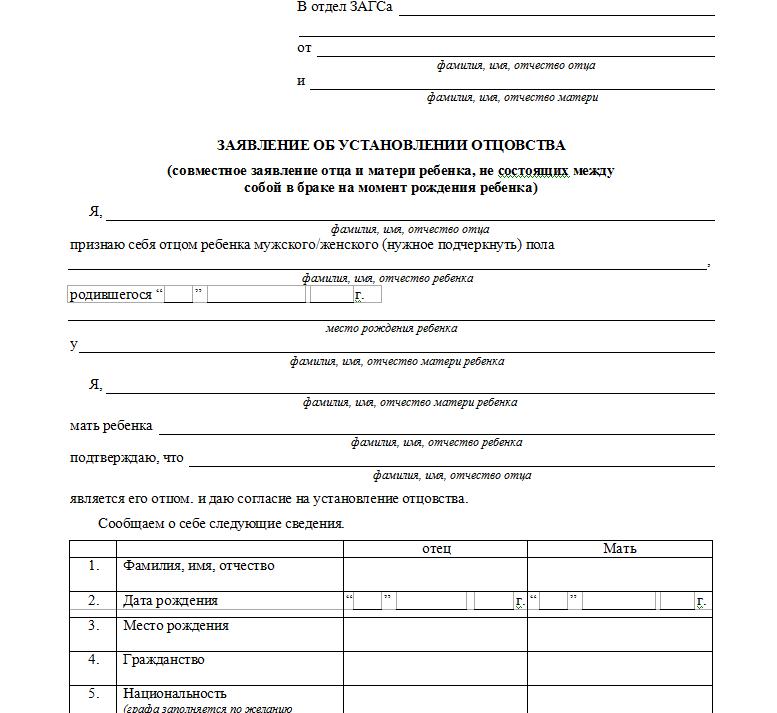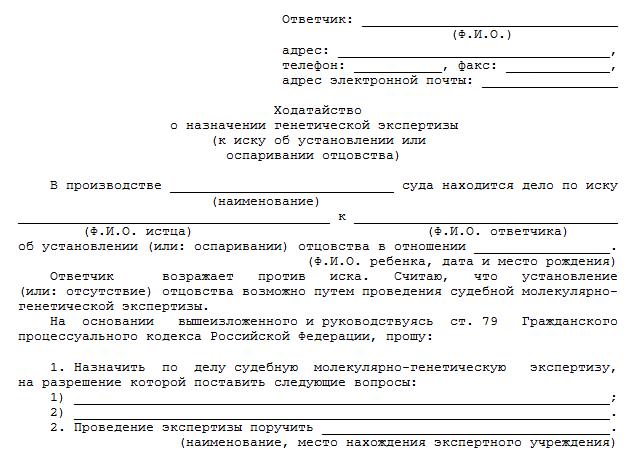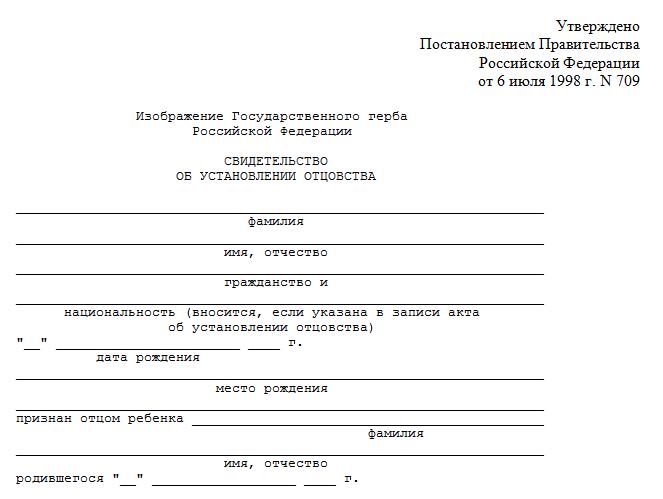If a man and a woman are not spouses, then after the birth of a child, a man does not become an official father. Often there are situations when a mother simply does not enter her father in a birth certificate or a man refuses to voluntarily acknowledge his paternity. In any case, the correct procedure for establishing paternity is carried out. The procedure can be performed voluntarily or forcefully. In the first case, you have to go to the registry office, and in the second case, a lawsuit is filed in court.
General information
The procedure on the basis of which paternity is established is distinguished by its duration and complexity. The features of this process include:
- the procedure for establishing paternity involves collecting numerous evidence that a man is truly a biological father to a child;
- often this requires an independent genetic examination;
- even witness statements are requested;
- often such cases affect the personal lives of citizens;
- the initiator of the process can be both mother and father;
- most often, a woman files a paternity claim for child support;
- if the procedure is performed by a man, then he wants to take part in the upbringing of his child.
Once paternity has been established, it must be borne in mind that for the child to cross the border or move to another residential building, parental consent will be required. The procedure for establishing paternity takes into account that the procedure can be performed at any time, since in such cases there is no limitation period. Therefore, the procedure can be initiated even after the child is 18 years old, but it is required to obtain permission from an adult citizen. If he is incompetent, then a representative of guardianship authorities acts on his behalf.

Concept of procedure
The establishment of paternity is represented by a procedure during which a particular citizen is recognized as the biological parent of a particular person. The process may be carried out on a voluntary or judicial basis. Its features include:
- the establishment of paternity on a voluntary basis is usually used if the man and woman are not in an official relationship, but they have a common child, so they submit an application to the registry office to recognize the man as the father of the baby;
- the process can be carried out even if the woman is married to another man who is not the father of the child;
- court order is used if one of the parents is against recognizing the man as father;
- most often, a mother who wishes to receive child support from a man applies to the court;
- often even a man files a lawsuit because he wants to raise a child.
The plaintiff may even be an immediate child who has reached the age of majority. Such a claim should be brought to court in civil proceedings. Simultaneously with the filing of such a claim, a woman may request the recovery of alimony. If the plaintiff does not have information about where the defendant is, then the search for a citizen may be initiated.
Purpose of
The procedure for establishing the fact of paternity is considered complex, and most often the process is implemented in court. Based on Art. 47 SK, all relations with children are based on the fact that citizens are recognized as their official parents. It does not matter if the parents are official spouses or not.
If the fact of paternity is established, then mutual rights and obligations arise. The most common obligation is to pay child support. Their size depends on the number of children the father has. The procedure for establishing paternity is used for numerous purposes:
- payment of alimony;
- inheritance after the death of the father;
- purpose of payments after the loss of the breadwinner;
- if the mother dies, then the father, after recognizing paternity, can start raising a child.
If a mother dies, then the process of recognizing a man as a father is carried out only in court.

Legal grounds
The establishment of paternity in a judicial proceeding on the basis of Art. 49 SK is carried out only in the presence of certain conditions. These include:
- there is no officially registered marriage between the parents of the minor;
- the man does not want to voluntarily acknowledge himself as a father;
- no consent is issued by the guardianship authorities for the voluntary recognition of a man as a biological parent.
A man can initiate legal proceedings if a mother dies, is declared legally incompetent, is deprived of her parental rights, or goes missing.
Process features
The establishment of paternity in the courts has many nuances:
- It is allowed to file a claim even during the pregnancy of a woman;
- the reason is the lack of official relations, so there is a possibility that after the birth of the child there will be no opportunity to submit an application to the registry office;
- often, even before birth, a DNA examination is carried out to determine whether a particular man is the father of the baby, if he has doubts;
- if a woman with a child plans to go to another country with her husband for permanent residence, then an examination by the embassy may be required, although the woman must consent to this.
When conducting trials, it is by all means taken into account precisely the rights and interests of the minor.
Voluntary order
Often used a voluntary procedure for establishing paternity of a child. In this case, the man and woman do not object to this process, therefore they jointly turn to the registry office. The procedure is divided into the following steps:
- an appropriate statement is drawn up containing a request to recognize a specific citizen as the father of a minor;
- documents are prepared that are the basis for the procedure;
- a full package of documents is transmitted to the registry office;
- if a positive decision is made, the man receives a certificate in his hands, in which his paternity is established.
Since the process is carried out voluntarily, the refusal is usually caused by errors in the statement, after the elimination of which there are no difficulties for recognizing the man as the father of the child.

Application Rules
When applying to the registry office, a statement is necessarily formed correctly. To do this, the rules are taken into account:
- it must have the consent of both parents to grant the man the corresponding rights to the minor;
- instead of a mother, consent can be drawn up by other persons who are currently responsible for the child;
- the application is drawn up by both the mother and father, if there is no possibility for the formation of one document.
A sample of such a statement can be taken directly from the registry office. Other documents are attached to the correctly drawn up application. They are represented by passports of both parents and a receipt on payment of the fee. The state duty for amendments is 350 rubles. Additionally, a birth certificate is required. If he is over 18, then he needs his written consent.

Judicial paternity
Step-by-step instructions for this process are divided into stages:
- the plaintiff draws up a statement of claim;
- documentation is attached to it, confirming that a really specific man is the father of the child;
- documentation is reviewed within 5 days by a special judicial commission;
- if a positive decision is made, the date of the preliminary hearing is set, which acts as preparation for the main trial;
- at the hearing, all available evidence is examined, their objectivity and reliability are evaluated, and if necessary, additional documents are requested from both participants;
- DNA testing is often prescribed;
- Further, several trials are held where the results of the examination and the evidence presented are evaluated;
- the testimonies of witnesses are heard;
- only after the completion of all these stages the judge makes an objective decision.
If the claim is satisfied, then the plaintiff with the received document from the court can contact the registry office to make the necessary entries about the father in the child’s documents. The establishment of paternity in a lawsuit is considered a complex process requiring the preparation of numerous documents and evidence. The court is not based solely on the results of DNA, therefore this information acts only as strong evidence.
If the man presents evidence that he is infertile on the basis of a previous medical examination, then the claims are not satisfied.
Can DNA Examination Be Forced?
The plaintiff or defendant may petition the court for DNA testing. This process is carried out exclusively with the consent of both participants in the process. Additionally, there must be reason to complete this process.
If the defendant does not come for examination on the appointed day, then this cannot become the basis for the automatic recognition of his paternity. Therefore, a decision is made without the results of this examination. The court evaluates other evidence received from the participants in the process. Based on these documents, paternity is established in a judicial proceeding. A father may submit medical certificates or documents from work confirming that at the time of conception he was in another city.

What documents are required?
To start the trial, the main purpose of which is the recognition of a particular citizen as the father of the child, the plaintiff must prepare certain documentation. The following papers belong to it:
- statement of claim;
- duty receipt;
- documents confirming the existence of grounds for filing claims;
- written testimony;
- child documentation.
When drawing up a claim, it is important to indicate the name of the court, as well as write down information about the plaintiff and defendant. All requirements should be summarized, but on the basis of the data provided it should be clear that the establishment of paternity in the courts is required. A sample of this statement can be studied below.

Is it possible to challenge?
If a woman really has evidence that a particular citizen is the father of her child, then the court satisfies the claims, so the man is recognized as the father of the minor. It is allowed to challenge such a court decision.
The contestation process can be initiated not only by the man, but also by the immediate child after reaching the age of majority. There must be good reason for this to refute the existence of kinship.

Conclusion
Paternity is established voluntarily or in a judicial proceeding. The process can be initiated by the mother or father of the child. If the procedure is carried out voluntarily, then you have to apply with the application and other documents to the registry office.
If a man refuses paternity, then he can be recognized as the father of the child by a court decision.For this, a woman should prepare as much evidence as possible. Additionally, DNA testing may be performed.
